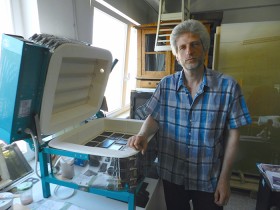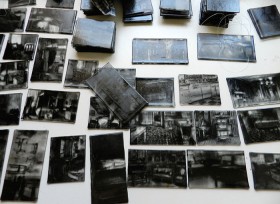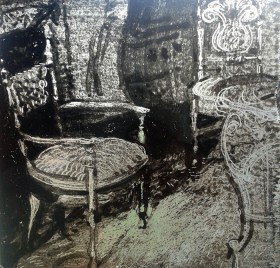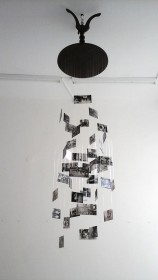
Daniel Wiesenfeld at work. The freshly baked glass plates cool off in the oven, 2015
© Jewish Museum Berlin, photo: Anna Golus
The last few weeks, while people everywhere were sizzling in the summer sun, Daniel Wiesenfeld was ‘baking’ a hundred new works of art for our art vending machine. What good luck, meanwhile, that the machine is nearly sold out!
Daniel is presenting the Jewish Museum Berlin with what is already the third series of works for the vending machine, all three of which are incomparable. In April we received a hundred oil paintings with self-portraits of the artist bearing a variety of poignant grimaces, along with a hundred charcoal drawings featuring a number of different motifs. For this new series, Daniel decided on a technique that’s new not only for him but for the vending machine as well: stained glass.
I visited Daniel a few days ago in Berlin’s Tempelhof neighborhood. He was able to use an electric kiln (indispensible for glass) here at the workshop of someone he knows. You have to heat the glass up incrementally to 650°C (1202°F) in order to fire it with colors, which Daniel had told me beforehand. It was an oppressively warm morning, so I was relieved when he said that he only runs the oven at night. The nightly firing was just finished and I could see the ‘freshly baked’ glass plates cooling off in the oven. More small glass panes were spread across a table. They feature views into dark interiors, a living room, a kitchen, a bedroom. In some of the pictures you can also see single objects or pieces of furniture: a rocking chair, a side table with a flower vase, and a stately canopy bed. There are no people. “A bed, a chair, a table” is the title of this series of unique handmade works.

Some artworks of the series “A bed, a chair, a table,” black stained glass art, 2015
© Jewish Museum Berlin, photo: Anna Golus
There’s a sealed jar with black powder on the table. The label on it shows a skull and crossbones and other warning symbols. Daniel produces his stained glass art out of conventional windowpane glass, which he paints with black stain. Black stain is a dye powder that contained lead oxide in its original form and was already being used for stained glass in the medieval period. It’s seldom used today, however, and Daniel had to search long and hard to find a lead-free formula.
The aesthetic effect of the black stain is revealed by the light. The rooms on the glass look to me like images from another era – like old, slightly-faded, black and white photographs.
This association is intentional. Daniel consciously turned for motifs to historical interior views with echoes of the Belle Epoque. And not only the motifs come from the past; the artificial ‘weathering process’ he puts the images through add to the effect. With a variety of techniques, Daniel generates the result that the rooms look mysterious, almost ghostly, as if behind a fine veil.
As we spoke, he explained that it’s particularly important to him that the rooms look lived-in but don’t reveal any actual people. “The people aren’t there anymore, but these rooms allow you to surmise something about their different stories. The presence of people still reverberates in the rooms like an echo.”
The human presence in a painting is a central theme in Daniel Wiesenfeld’s work. Not surprising, when you recall that he’s primarily known as a portrait painter. Many of his portraits were commissioned. (A selection can be seen at his homepage.) Daniel states: “Portraits have fascinated me since childhood – paintings that respond to your gaze, with a likeness that seems to offer you an animated counterpart. With my own portraits it’s important to me, beyond the superficial rendering of resemblance, to allow a deeper insight into the character of my subject.”
Daniel was born in the USA and grew up in Bavaria. He studied art, with an emphasis on painting, at the Academy of Fine Arts in Munich and at Queens College in New York. He has lived with his family since 2000 in Berlin. In recent weeks he’s been in close contact with the curators of the permanent exhibition where the art vending machine can be found. “A project like the art vending machine prompts you to grapple with the work more intensively,” Daniel thinks. And so one project leads to another. Inspired by the first glass panes of the series “A bed, a chair, a table,” Daniel created an installation of the same name which became part of the exhibition “Black & White” at HilbertRaum. The “glass interiors” were attached to a table on nylon threads hanging from the ceiling overhead. Like glass wind chimes that, depending on the incidence of light, reveal to the viewer another room altogether.
Before leaving Daniel and stepping out into the broiling midday sun, I get to hear about his latest project, a combination of oil painting and stained glass. He names some of the key points: three-dimensionality, perspective, lighting effects. It sounds really interesting. “I have very many ideas,” he says. “I think it has a lot of potential.”
After her induction into the mysteries of stained glass, Anna Golus is keenly awaiting Daniel’s next project.

